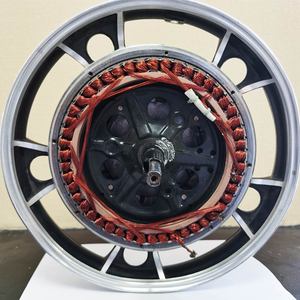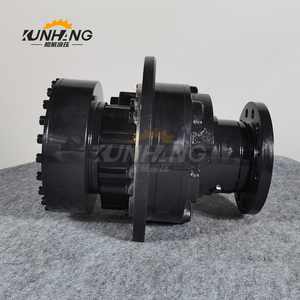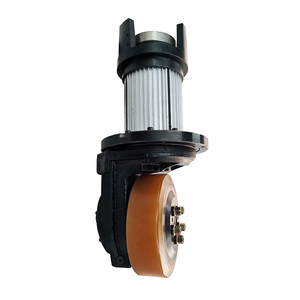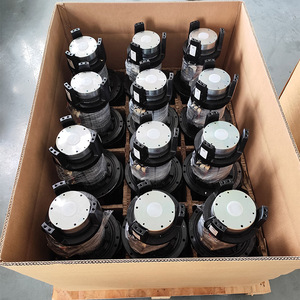
All categories
Featured selections
Trade Assurance
Buyer Central
Help Center
Get the app
Become a supplier

(946 products available)










































There are several types of motor assemblies for stacker drive wheels. The shape, size, and characteristics of these subsequent systems depend largely on the kind of operation and environment. Thus, here is a list of the most common types available:
Gear motors are used because they have high torque right at the start. This is especially valuable when lifting heavy items with a pallet stacker. Most pallet stackers have gear motors directly linked to the drive wheels. Thus, the drive wheel motor assembly would help with heavy lifting or pushing.
Pneumatic motor components rarely exist in pallet stackers. Yet, they might be employed in places where quiet operations are required. However, the use of hydraulic pump and motor systems to allow smooth operation while providing enough strength to carry heavy loads.
Chain-and-sprocket motors comprise another type of geared motor. It transfers power from the motor to the drive wheel using a chain and sprocket arrangement. Hence, this system is ideal for heavy-duty applications since it offers more strength and durability than belt-driven motors.
As the name says, direct drive motors have their output shaft directly connected to the driven wheel. Direct-driven motors have fewer moving components than other drive systems. In addition, they need less upkeep and support, making them perfect for use in stacked pallet handlers.
Hydraulic motors are common in stacker drive wheel motor assemblies. These electric over hydraulic switches offer a lot of power and precision in the process. Moreover, they are often used in counterbalance stackers that require strong hydraulic pressure to lift high-weight loads vertically.
Drive wheel motor assemblies are designed for stackers. Besides that, they are well applied across several industries. This is due to their versatility and efficiency when it comes to handling and transporting goods. The products of these drive wheel motor assemblies are explained in detail below:
Pallet jacks are common in warehouses for inventory management. The drive wheel motors help these pallet stackers move and efficiently manage the operation. In addition, they provide the necessary strength to shift pallets and items amid storage racking systems.
Motor assemblies for stacker drive wheels are used in manufacturing facilities for moving raw materials and completed items. Thus, the stackers assist in transporting hefty machinery parts, minimizing the workforce's physical effort and efficiency gains in the manufacturing business.
Stacks are commonly used in distribution centers by pallet jacks to quickly move and distribute products. Good stacker drive wheel motor assemblies increase the capability of stackers to load trucks, manage inventory, and handle larger workloads in busy distribution settings.
Stackers are helpful in retail stock-rooms to handle large product pallets. Stackers assist in moving products from storage to sales floors and replenishing inventory, particularly in larger businesses when manual movement of items is unbearable.
In the food and beverage sector, heavy items like ingredients, packaging materials, and final products are frequently moved using stackers. The drive wheel motors of the stackers provide smooth and efficient transportation, assisting firms in complying with safety regulations and avoiding accidents related to manual handling.
Stackers help move automobile components, tools, and raw materials within production plants and storage sections. Stacker drive wheel motor assemblies enhance the effectiveness of this transportation method while providing the required torque and mobility to lift and transport heavy things.
Motor Power
The motor power influences the stacking and pallet transport capabilities. Strong motors can lift large loads and move them over long areas without problems. The motor power rating ensures that the drive wheel motor assembly can handle certain industrial applications.
Gear Ratio
The gear ratio for gear-reduction systems is defined as high gear ratios. The high gear ratios provided good torque for applications that required lifting pallets. However, low gear ratios support functions like moving the stacker about relatively smooth surfaces.
Hydraulic Pump Specifications
The hydraulic pump specifications become relevant when analyzing hydraulic motor assemblies. Therefore, the hydraulic pump's capacity determines the stacker's lifting potential. A properly designed pump will ensure the execution of many stacking processes without stressing the system.
Wheel Material
The drive wheel assembly material influences the durability and frictional properties of the component. Rubber compounds give excellent grip and are relatively silent, especially on smooth floors. However, polyurethane wheels would be advantageous on tough surfaces since they endure longer and provide a better push.
Compatibility with Battery Systems
It is important to know the compatibility of the battery systems of a motor assembly. After all, the efficiency and performance attributes of electric pallet stackers solely depend on battery power. However, these compatible assemblies should be used with low-maintenance, long-lasting batteries to achieve optimal energy efficiency and stacker use.
Prior to performing any installations, all required tools and materials must first be gathered.
Tool and Materials
These includes a new drive wheel motor assembly, several wrenches or sockets, screwdrivers, a lift or jack, and possibly some sealing or locking compounds.
Safety Measure
Create safety precautions and ensure safety in the working environment. That is, turn off any electrical devices and ensure no exposure to electricity. Also, the stacked pallet must be empty and safe, ensuring safe working procedures to avoid accidents.
Removing Old Assembly
Begin by taking off the drive wheel. Thus, removing any encasing elements, displacing the bolts or screws linked to the motor assembly. The stacking components controlling the old assembly should be unhooked.
Mounting the New Motor
The new drive wheel motor assembly should then be installed in the stacker. It is essential to bolt the motor to the right mounting plates and connect the drive wheel to the right axis.
Reconnecting
Reattach all electrical connections, hydraulic lines, or other connections that were detached to install the new motor assembly. Ensure these connections are secure and tight to avoid issues with performance.
Testing
After completing the new installation, perform a test run to check whether the unit runs smoothly. The stacker should be observed for any strange noises, vibrations, or error codes. Also, ensure that the hydraulic lifting mechanism is working properly.
Regular Inspection
Checks must be frequent to ensure that the drive wheel motor assembly is performing its best. Look for wear on linked cables, parts that may have come loose, and signboards of rust or damage. This should also involve an examination of the mounting environment for general deterioration.
Lubrication
The lubrication of the assembly is crucial in reducing friction and thus increasing the durability of the motor and connected parts. Use a moderate-quality lubricant suggested by the manufacturer and apply it to the motor's moving sections.
Hydraulic Fluid
The hydraulic fluid involved in the motor assembly must be frequently changed for optimal performance. Thus, only use the fluid indicated by the manufacturer's manual, as using the wrong fluid can ruin the system. Be mindful of the fluid levels in the motor assembly and always top them off when they get low.
Wear and Tear Examination
The only way to reduce wear and tear examinations is by frequently replacing worn-out parts. This includes bearings, drive wheels, and other linked mechanical components. The examination of these components must be frequent so that when there is a need to replace them, it will be easy to detect.
Professional Servicing
Seek help from a professional service for major repairs or maintenance activities that are beyond understanding. Hence, a professional will conduct an assessment and repair of the assembly with the aid of appropriate maintenance equipment and technical expertise.
Choosing the right equipment entails evaluating several important variables so that what is chosen matches operational requirements. Here are the following considerations to assist in the selection process:
The first requirement to consider is the stacker's load capacity. High-capacity stackers need powerful motor assemblies, while low-capacity ones can make do with average ones. Hence, the motor assembly must sustain the common maximum load that will be dealt with in operations so that there will be no breakdown.
Next, the assembly's durability is essential, especially in environments where the equipment is subject to constant use. A drive wheel motor assembly made from industrial-grade components like steel and iron will handle wear and tear comparably better.
It is crucial to know the type of environment where the stacker will be working. Wet or corrosive environments will require a motor assembly in corrosion-resistant material. Furthermore, if the environment is rough, opt for one with shock-absorbing or tough-bearing materials. Thus, such considerations will ensure that the assembly handles environmental conditions.
Motor power will directly influence how well the assembly performs the task. A more powerful motor will be helpful when moving large items or handling ramps. Going for a highly efficient motor will save future operational costs, and having one with great power will help in tough working conditions.
An ideal stacker drive wheel motor assembly should have the least maintenance needs. However, assemblies with fewer wearing parts, like the hydraulic motor, require less maintenance, making them ideal for selection. This will also help have professional or unprofessional workers maintain the equipment.
So, while the costs of the assembly are not a direct consideration, they will affect the decision to make. Avoiding low-cost assemblies will affect the overall productivity of the equipment, while expensive ones are not a solution for the problem itself. Therefore, the costs have to be evaluated against the quality thereof so that reasonable costs will give reasonable products.
A. The weight it can lift, the environment it will be used in, and how often it will be operated or exposed to wear are the issues that influence the choice of the drive wheel motor assembly within stackers. Additionally, the materials and disturbance levels of the surrounding conditions will have an impact on the overall environmental durability level of the given assembly.
A. Such an assembly connects the motor directly to the drive wheel shaft. It eliminates the need for other linked mechanical components to transfer power, making the assembly very efficient and with very little maintenance. The direct drive motor assemblies typically provide improved efficiency in moving and handling materials for stackers.
A. Battery compatibility is vital since the efficiency of electric stackers relies heavily on battery performance. Also, a compatible stacker drive wheel motor assembly does not limit energy and time during the performance enhancement of the tool. Plus, good battery and motor assembly compatibility will eliminate operational problems.
A. The hydraulic fluid should usually be replaced every year or after the manufacturer-recommended number of hours of operation. For stacked pallet equipment that goes through a lot of routine work, the fluid should frequently be replaced, commonly, every few months or so, based on how hard it is used.
A. Yes, many modern assemblies are environmental-friendly, energy-efficient, and easy-to-use versions with battery-powered options. These stacker designs allow more maneuverability, principally when created for interior usage, such as in offices.